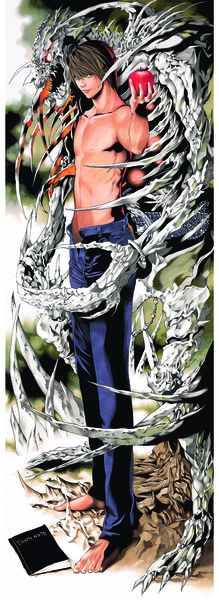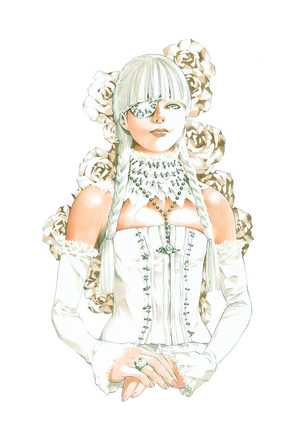Review
by Rebecca Silverman,blanc et noir: Takeshi Obata Illustrations
Artbook
| Synopsis: |  |
||
A collection of Takeshi Obata's artwork from the early 2000s, including art from Death Note, Hikaru no Go, and original pieces. |
|||
| Review: | |||
Even if you aren't a fan of the series he has illustrated, it is hard to deny that his artwork is impressive. Showing a firmer grasp of human anatomy than many other mainstream mangaka along with beautiful composition skills, Obata's artwork isn't just good manga art, it's good art. While I recognize that that is a subjective statement, a glance through Blanc et Noir should be enough to see some of what he is capable of in a range of pieces that cover his career between 2001 and 2006. The first thing worth remarking on is Viz's edition of this collection. While it does have a very high price point ($99 for the limited edition reviewed here), it is beautifully put together. The large book comes in a stiff slipcover with a silver-embossed cut-out frame, into which you can insert a variety of images, which come as frameable double-sided prints of selections from the artbook's contents on glossy stock. I would call this a coffee table book, but it's more a display piece, simply because you wouldn't want anyone accidentally setting a drink on it or using it as a hard surface. The prints include Hikaru no Go, Death Note, and two original works, with the majority of the images being from Death Note. That is the true focus of this collection, but as has been said before, familiarity with or fondness for that particular series is not a requirement of appreciating this book. Some of Obata's most impressive works are in this section, including several fold-out pieces, one of which is a work original to this collection. The rest of the Spécialité section is made up of images from a light novel series Obata illustrated, and it, along with a small section on the manga series Ayatsuri Sakon, written by Masaru Miyazaki, is much more innocent than almost anything else, with even the Hikaru no Go chapter having some darker imagery. The light novel illustrations (the series is Soshite Kanojo) are definitely the cutest, featuring a spunky young girl who can clearly take care of herself. Even Obata's “cute” illustrations have an element of power to them, and just looking at these pictures makes you want to know the story that goes with them. This also goes for the Karakurizoshi Ayatsuri Sakon images, which feature much richer colors than Obata's other images; he remarks in his commentary that he was trying to use colors that captured the essence of Japan. The other chapters that make up the book are, of course, Hikaru no Go, along with Bobobo-bo bo-bobo and illustrations for the samurai-themed game Yoshitsune-ki. Both the first and last include more fold-out illustrations on different paper stock than the rest of the book, making them especially interesting. The Hikaru no Go section also makes use of tissue-thin paper to cover some of the images of Sai, giving him the requisite ghostly appearance while also romanticizing the Heian Era imagery. The pictures of Sai are some of the most ephemeral in the collection, and even if Obata's technique is clearly not quite as developed as it is in Death Note, these are some of the gentlest, most exquisite works in the book. You don't need to be a fan of Takeshi Obata's stories to appreciate his art, and this book is one that should appeal to anyone looking to see just how professional (in a classical academic sense) manga art can be. It's pricey, but if you're a collector this is a book you absolutely want to own. Not only will it prove to your stodgy art teacher that “anime stuff” is real art, but it is also the kind of book that you can spend hours looking at, just to absorb all of the details. OBATA TAKESHI ILLUSTRATIONS -Blanc et Noir- © 2006 by Takeshi Obata/SHUEISHA Inc. |
| Grade: | |||
|
Overall : A
Art : A
+ Beautiful edition, a chance to see some of Obata's lesser-known series work. Lots of fold out images and a nice selection of prints to use as the cover (or frame). |
|||
| discuss this in the forum (10 posts) | | |||
| Production Info: | ||
|
Full encyclopedia details about Release information about |
||
 While Obata does tend to elongate the human form, presumably for aesthetic purposes, he also states in his commentary that he always thinks about bone structure when drawing human figures, something that really shows in pictures such as the one at left. There is a clear understanding of how muscles attach to the bones beneath, a plausibility that is not at odds with the particular aesthetics of the manga style. Even the bones of the beast wrapped around the human figure have a realism that works, no matter how implausible the existence of such a creature may be. This attention to how things are put together is a mainstay of Obata's artwork, as can be seen in his Frankensteined man in the “Spécialité” section on page 72. Obata comments that he got the idea for this image from Manga Erotics f from the Death card in a Tarot deck, and it is a bit surprising that the image isn't from Death Note, as it shares many thematic similarities. In the case of this image, “put together” is taken very literally, as the man is a stitchling, pieced together out of many different fleshes. The pull of stitches against skin and the uneven quality of the stitching makes for fascinating detail, albeit a little unsettling.
The Spécialité section is probably the most interesting, if only because we rarely see Obata's non-manga art. Mainly he uses this section to show his drawings of females, something he mentions several times in his commentary that he wishes he got to draw more often. Three images really stand out from this chapter, two original to the book and one from Ultra Jump in 2002. That picture is what he calls a grotesque Little Red Riding Hood, although anyone familiar with current imagery of that character will recognize it as far less disturbing than many other pictures of Red. The Gothic Lolita style image is slightly faded, and the sexualized male werewolves in the back may indicate that Obata did some research before drawing the picture, as they hearken back to one of the earliest versions of the tale, while the contents of her basket run the gamut of the story's history. Likewise the next two pieces also hearken to Western folklore in their use of black and white to represent danger/badness and goodness/purity, with a few twists.
While Obata does tend to elongate the human form, presumably for aesthetic purposes, he also states in his commentary that he always thinks about bone structure when drawing human figures, something that really shows in pictures such as the one at left. There is a clear understanding of how muscles attach to the bones beneath, a plausibility that is not at odds with the particular aesthetics of the manga style. Even the bones of the beast wrapped around the human figure have a realism that works, no matter how implausible the existence of such a creature may be. This attention to how things are put together is a mainstay of Obata's artwork, as can be seen in his Frankensteined man in the “Spécialité” section on page 72. Obata comments that he got the idea for this image from Manga Erotics f from the Death card in a Tarot deck, and it is a bit surprising that the image isn't from Death Note, as it shares many thematic similarities. In the case of this image, “put together” is taken very literally, as the man is a stitchling, pieced together out of many different fleshes. The pull of stitches against skin and the uneven quality of the stitching makes for fascinating detail, albeit a little unsettling.
The Spécialité section is probably the most interesting, if only because we rarely see Obata's non-manga art. Mainly he uses this section to show his drawings of females, something he mentions several times in his commentary that he wishes he got to draw more often. Three images really stand out from this chapter, two original to the book and one from Ultra Jump in 2002. That picture is what he calls a grotesque Little Red Riding Hood, although anyone familiar with current imagery of that character will recognize it as far less disturbing than many other pictures of Red. The Gothic Lolita style image is slightly faded, and the sexualized male werewolves in the back may indicate that Obata did some research before drawing the picture, as they hearken back to one of the earliest versions of the tale, while the contents of her basket run the gamut of the story's history. Likewise the next two pieces also hearken to Western folklore in their use of black and white to represent danger/badness and goodness/purity, with a few twists.  The two are side-by-side in the book, which makes it easy to compare and contrast the two women: the one in black with her eyes slightly closed, her mouth partially open, and her gaze directly at the viewer, while the woman in white has her mouth almost pursed, her one eye staring into the distance, and her figure totally obscured by her corset-like top.
The two are side-by-side in the book, which makes it easy to compare and contrast the two women: the one in black with her eyes slightly closed, her mouth partially open, and her gaze directly at the viewer, while the woman in white has her mouth almost pursed, her one eye staring into the distance, and her figure totally obscured by her corset-like top.